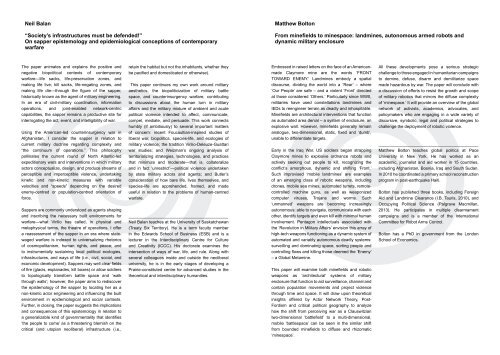transnational northeast
ULDX abstracts - Between Architecture of War and Military Urbanism
ULDX abstracts - Between Architecture of War and Military Urbanism
- No tags were found...
Create successful ePaper yourself
Turn your PDF publications into a flip-book with our unique Google optimized e-Paper software.
Neil Balan<br />
“Society’s infrastructures must be defended!”<br />
On sapper epistemology and epidemiological conceptions of contemporary<br />
warfare<br />
Matthew Bolton<br />
From minefields to minespace: landmines, autonomous armed robots and<br />
dynamic military enclosure<br />
The paper animates and explains the positive and<br />
negative biopolitical contexts of contemporary<br />
warfare—life sacks, life-preservation zones, and<br />
making life live; kill sacks, life-negating zones, and<br />
making life die—through the figure of the sapper,<br />
historically known as the agent of military engineering.<br />
In an era of civil-military coordination, information<br />
operations, and joint-enabled network-centric<br />
capabilities, the sapper remains a productive site for<br />
interrogating the act, event, and intelligibility of war.<br />
Using the American-led counterinsurgency war in<br />
Afghanistan, I consider the sapper in relation to<br />
current military doctrine regarding complexity and<br />
“the continuum of operations.” This philosophy<br />
pollinates the current round of North Atlantic-led<br />
expeditionary wars and interventions in which military<br />
actors conceptualize, design, and produce streams of<br />
perceptible and imperceptible violence, undertaking<br />
kinetic and non-kinetic measures with variable<br />
velocities and “speeds” depending on the desired<br />
enemy-centred or population-centred orientation of<br />
force.<br />
Sappers are commonly understood as agents shaping<br />
and inscribing the necessary built environments for<br />
warfare—what Virilio has called, in physical and<br />
metaphysical terms, the theatre of operations. I offer<br />
a reassessment of the sapper in an era where statewaged<br />
warfare is indexed to universalizing rhetorics<br />
of cosmopolitanism, human rights, and peace; and<br />
to instrumentally sustaining local political ecologies,<br />
infrastructures, and ways of life (i.e., civil, social, and<br />
economic development). Sappers may well clear fields<br />
of fire (glacis, esplanades, kill boxes) or allow soldiers<br />
to topologically transform battle space and ‘walk<br />
through walls’; however, the paper aims to rediscover<br />
the epistemology of the sapper by locating her as a<br />
non-kinetic actor engineering and influencing the built<br />
environment in epidemiological and social contexts.<br />
Further, in closing, the paper suggests the implications<br />
and consequences of this epistemology in relation to<br />
a generalizable kind of governmentality that identifies<br />
‘the people to come’ as a threatening blemish on the<br />
critical (and utopian neoliberal) infrastructure (i.e.,<br />
retain the habitat but not the inhabitants, whether they<br />
be pacified and domesticated or otherwise).<br />
This paper continues my own work around military<br />
aesthetics, the biopoliticization of military battle<br />
space, and counterinsurgency warfare, contributing<br />
to discussions about the human turn in military<br />
affairs and the military mixture of ambient and acute<br />
political violence intended to affect, communicate,<br />
compel, mediate, and persuade. This work connects<br />
humbly (if ambitiously) to several important matters<br />
of concern: recent Foucaultian-inspired studies of<br />
liberal war, biopolitics, species-life, and ecologies of<br />
military violence; the tradition Virilio-Deleuze-Guattari<br />
war studies; and Weizman’s ongoing analysis of<br />
territorializing strategies, technologies, and practices<br />
that minimize and moderate—that is, collateralize<br />
and in fact ‘unrestrict’—political violence undertaken<br />
by state military actors and agents; and Butler’s<br />
consideration of how bare life, lives themselves, and<br />
species-life are apprehended, framed, and made<br />
useful in relation to the problems of human-centred<br />
warfare.<br />
___________________________________________<br />
Neil Balan teaches at the University of Saskatchewan<br />
(Treaty Six Territory). He is a term faculty member<br />
in the Edwards School of Business (ESB) and is a<br />
lecturer in the Interdisciplinary Centre for Culture<br />
and Creativity (ICCC). His doctorate examines the<br />
intersection of ways of war, life, and rule. Along with<br />
several colleagues inside and outside the neoliberal<br />
university, he is in the early stages of developing a<br />
Prairie-constituted centre for advanced studies in the<br />
theoretical and interdisciplinary humanities.<br />
Embossed in raised letters on the face of an Americanmade<br />
Claymore mine are the words ‘FRONT<br />
TOWARD ENEMY.’ Landmines embody a spatial<br />
discourse, dividing the world into a ‘Rear’ – where<br />
‘Our People’ are safe – and a violent ‘Front’ directed<br />
at those considered ‘Others.’ Particularly since WWII,<br />
militaries have used constellations landmines and<br />
IEDs to reengineer terrain as deadly and inhospitable.<br />
Minefields are architectural interventions that function<br />
as automated area denial – a system of enclosure, an<br />
explosive wall. However, minefields generally remain<br />
analogue, two-dimensional, static, fixed and ‘dumb’,<br />
unable to differentiate targets.<br />
Early in the Iraq War, US soldiers began strapping<br />
Claymore mines to explosive ordnance robots and<br />
actively seeking out people to kill, recognizing the<br />
conflict’s amorphous, dynamic and shifting ‘Front.’<br />
Such improvised ‘mobile landmines’ are examples<br />
of an emerging class of robotic weapons, including<br />
drones, mobile sea mines, automated turrets, remotecontrolled<br />
machine guns, as well as weaponized<br />
computer viruses, Trojans and worms. Such<br />
‘unmanned’ weapons are becoming increasingly<br />
autonomous: able to navigate, communicate with each<br />
other, identify targets and even kill with minimal human<br />
involvement. Pentagon intellectuals associated with<br />
the ‘Revolution in Military Affairs’ envision this array of<br />
high-tech weapons functioning as a dynamic system of<br />
automated and variably autonomous deadly systems:<br />
surveilling and dominating space, sorting people and<br />
controlling flows and killing those deemed the ‘Enemy’<br />
– a Global Metamine.<br />
This paper will examine both minefields and robotic<br />
weapons as ‘architectural’ systems of military<br />
enclosure that function to aid surveillance, channel and<br />
contain population movements and project violence<br />
through time and space. It will draw upon theoretical<br />
insights offered by Actor Network Theory, Post-<br />
Fordism and critical political geography to analyze<br />
how the shift from perceiving war as a Clauswitzian<br />
two-dimensional ‘battlefield’ to a multi-dimensional,<br />
mobile ‘battlespace’ can be seen in the similar shift<br />
from bounded minefields to diffuse and rhizomatic<br />
‘minespace’.<br />
All these developments pose a serious strategic<br />
challenge to those engaged in humanitarian campaigns<br />
to demine, defuse, disarm and demilitarize space<br />
made hazardous by war. The paper will conclude with<br />
a discussion of efforts to resist the growth and scope<br />
of military robotics that mirrors the diffuse complexity<br />
of ‘minespace.’ It will provide an overview of the global<br />
network of activists, academics, advocates, and<br />
policymakers who are engaging in a wide variety of<br />
discursive, symbolic, legal and political strategies to<br />
challenge the deployment of robotic violence.<br />
___________________________________________<br />
Matthew Bolton teaches global politics at Pace<br />
University in New York. He has worked as an<br />
academic, journalist and aid worker in 15 countries,<br />
including Afghanistan, Bosnia, Iraq and South Sudan.<br />
In 2010 he coordinated a primary school reconstruction<br />
program in post-earthquake Haiti.<br />
Bolton has published three books, including Foreign<br />
Aid and Landmine Clearance (I.B. Tauris, 2010), and<br />
Occupying Political Science (Palgrave Macmillan,<br />
2013). He participates in multiple disarmament<br />
campaigns and is a member of the International<br />
Committee for Robot Arms Control.<br />
Bolton has a PhD in government from the London<br />
School of Economics.












